Simple Preparation of Conductive Hydrogels Based on Precipitation Method for Flexible Wearable Devices
Highlights
- A novel precipitation method via solution blending and centrifugation was developed for the facile preparation of conductive polymer composite hydrogels (e.g., PEDOT/PAA/PVA).
- The prepared hydrogels exhibit excellent electrical (conductivity: 4.065 S/m) and mechanical (Young’s modulus: 311.6 kPa) properties, and perform well as strain sensors (sensitivity: 1.86; response time: 400 ms) and bioelectrodes (lower contact impedance than commercial electrodes, and showed no signs of skin irritation under tested conditions).
- The method shows universal applicability for different conductive polymers (e.g., PANI, PPy) and hydrogel substrates (e.g., PVA, PAAm).
- It provides a universal, simple, and low-cost strategy for rapid synthesis of customizable conductive hydrogels, overcoming limitations of traditional complex methods.
Abstract
1. Introduction
2. Materials and Methods
2.1. Materials
2.2. Preparation of PEDOT/PAA/PVA Hydrogels
2.3. Preparation of PAA/PVA Hydrogels
2.4. Material Characterization
2.5. Conductivity Test
2.6. Skin Contact Impedance Measurement of Hydrogels
2.7. Mechanical Property Test
2.8. Strain Sensor Performance Test
2.9. Bioelectrode Performance Test
2.10. Universality of the Preparation Methods
3. Results and Discussion
3.1. Preparation of PEDOT/PAA/PVA Hydrogels
3.2. The Characteristics of PEDOT/PAA/PVA Hydrogels
3.3. The Application of PEDOT/PAA/PVA Hydrogels
3.4. Universal Applicability for the Preparation of Conductive Hydrogels
4. Conclusions
Supplementary Materials
Author Contributions
Funding
Institutional Review Board Statement
Informed Consent Statement
Data Availability Statement
Conflicts of Interest
References
- Khan, Y.; Ostfeld, A.E.; Lochner, C.M.; Pierre, A.; Arias, A.C. Monitoring of Vital Signs with Flexible and Wearable Medical Devices. Adv. Mater. 2016, 28, 4373–4395. [Google Scholar] [CrossRef] [PubMed]
- Wang, X.; Yu, J.; Cui, Y.; Li, W. Research progress of flexible wearable pressure sensors. Sens. Actuators A Phys. 2021, 330, 112838. [Google Scholar] [CrossRef]
- Feiner, R.; Dvir, T. Tissue–electronics interfaces: From implantable devices to engineered tissues. Nat. Rev. Mater. 2017, 3, 17076. [Google Scholar] [CrossRef]
- Chen, G.; Xiao, X.; Zhao, X.; Tat, T.; Bick, M.; Chen, J. Electronic Textiles for Wearable Point-of-Care Systems. Chem. Rev. 2021, 122, 3259–3291. [Google Scholar] [CrossRef]
- Xu, L.; Huang, Z.; Deng, Z.; Du, Z.; Sun, T.L.; Guo, Z.; Yue, K. A Transparent, Highly Stretchable, Solvent-Resistant, Recyclable Multifunctional Ionogel with Underwater Self-Healing and Adhesion for Reliable Strain Sensors. Adv. Mater. 2021, 33, 2105306. [Google Scholar] [CrossRef]
- Han, Y.; Dai, L. Conducting Polymers for Flexible Supercapacitors. Macromol. Chem. Phys. 2019, 220, 1800355. [Google Scholar] [CrossRef]
- Shi, Y.; Fu, X.; Wang, W.; Yu, D. Stretchable, adhesive and low impedance hydrogel prepared by one-pot method used as ECG electrodes. Colloids Surf. A Physicochem. Eng. Asp. 2023, 662, 130998. [Google Scholar] [CrossRef]
- Hsieh, J.-C.; Alawieh, H.; Li, Y.; Iwane, F.; Zhao, L.; Anderson, R.; Abdullah, S.I.; Tang, K.W.K.; Wang, W.; Pyatnitskiy, I.; et al. A highly stable electrode with low electrode-skin impedance for wearable brain-computer interface. Biosens. Bioelectron. 2022, 218, 114756. [Google Scholar] [CrossRef]
- Liu, J.; Wang, W.; Li, H.; Huo, P.; Teng, P.; Ding, H.; Shen, X. Recent progress in fabrications, properties and applications of multifunctional conductive hydrogels. Eur. Polym. J. 2024, 208, 112895. [Google Scholar] [CrossRef]
- Correa, S.; Grosskopf, A.K.; Hernandez, H.L.; Chan, D.; Yu, A.C.; Stapleton, L.M.; Appel, E.A. Translational Applications of Hydrogels. Chem. Rev. 2021, 121, 11385–11457. [Google Scholar] [CrossRef] [PubMed]
- Wang, B.; Xu, W.; Yang, Z.; Wu, Y.; Pi, F. An Overview on Recent Progress of the Hydrogels: From Material Resources, Properties, to Functional Applications. Macromol. Rapid Commun. 2022, 43, 2100785. [Google Scholar] [CrossRef]
- Nele, V.; Wojciechowski, J.P.; Armstrong, J.P.; Stevens, M.M. Tailoring Gelation Mechanisms for Advanced Hydrogel Applications. Adv. Funct. Mater. 2020, 30, 2002759. [Google Scholar] [CrossRef]
- Peng, Q.; Chen, J.; Wang, T.; Peng, X.; Liu, J.; Wang, X.; Wang, J.; Zeng, H. Recent advances in designing conductive hydrogels for flexible electronics. InfoMat 2020, 2, 843–865. [Google Scholar] [CrossRef]
- Zhao, Y.; Ohm, Y.; Liao, J.; Luo, Y.; Cheng, H.-Y.; Won, P.; Roberts, P.; Carneiro, M.R.; Islam, M.F.; Ahn, J.H.; et al. A self-healing electrically conductive organogel composite. Nat. Electron. 2023, 6, 206–215. [Google Scholar] [CrossRef]
- Yang, X.; Sun, M.; Bian, Y.; He, X. A Room-Temperature High-Conductivity Metal Printing Paradigm with Visible-Light Projection Lithography. Adv. Funct. Mater. 2019, 29, 1807615. [Google Scholar] [CrossRef]
- Pan, L.; Yu, G.; Zhai, D.; Lee, H.R.; Zhao, W.; Liu, N.; Wang, H.; Tee, B.C.K.; Shi, Y.; Cui, Y.; et al. Hierarchical nanostructured conducting polymer hydrogel with high electrochemical activity. Proc. Natl. Acad. Sci. USA 2012, 109, 9287–9292. [Google Scholar] [CrossRef]
- Liu, H.; Liu, M.; Zhang, L.; Ma, L.; Chen, J.; Wang, Y. Dual-stimuli sensitive composites based on multi-walled carbon nanotubes and poly(N,N-diethylacrylamide-co-acrylic acid) hydrogels. React. Funct. Polym. 2010, 70, 294–300. [Google Scholar] [CrossRef]
- Chatterjee, S.; Lee, M.W.; Woo, S.H. Enhanced mechanical strength of chitosan hydrogel beads by impregnation with carbon nanotubes. Carbon 2009, 47, 2933–2936. [Google Scholar] [CrossRef]
- Xiao, Y.; He, L.; Che, J. An effective approach for the fabrication of reinforced composite hydrogel engineered with SWNTs, polypyrrole and PEGDA hydrogel. J. Mater. Chem. 2012, 22, 8076–8082. [Google Scholar] [CrossRef]
- Wei, H.; Kong, D.; Li, T.; Xue, Q.; Wang, S.; Cui, D.; Huang, Y.; Wang, L.; Hu, S.; Wan, T.; et al. Solution-Processable Conductive Composite Hydrogels with Multiple Synergetic Networks toward Wearable Pressure/Strain Sensors. ACS Sens. 2021, 6, 2938–2951. [Google Scholar] [CrossRef]
- Shi, W.; Han, G.; Chang, Y.; Song, H.; Hou, W.; Chen, Q. Using Stretchable PPy@PVA Composites as a High-Sensitivity Strain Sensor To Monitor Minute Motion. ACS Appl. Mater. Interfaces 2020, 12, 45373–45382. [Google Scholar] [CrossRef]
- Wang, T.; Xu, B.; Yu, T.; Yu, Y.; Fu, J.; Wang, Y.; Gao, X.; Xue, Z.; Li, R.; Chang, G. PVA/chitosan-based multifunctional hydrogels constructed through multi-bonding synergies and their application in flexible sensors. Carbohydr. Polym. 2024, 350, 123034. [Google Scholar] [CrossRef]
- Li, S.; Cong, Y.; Fu, J. Tissue adhesive hydrogel bioelectronics. J. Mater. Chem. B 2021, 9, 4423–4443. [Google Scholar] [CrossRef]
- Wang, D.; Qin, L.; Yang, W.; He, Y.; Zhang, S.; Yang, Y.; Xu, K.; Gao, P.; Yu, J.; Cai, K. A Conductive Hydrogel Based on GaIn and PVA/PAA/Fe 3+ for Strain Sensor and Physiological Signal Detection. ACS Appl. Polym. Mater. 2021, 3, 5268–5276. [Google Scholar] [CrossRef]
- Liu, Y.; Tan, G.; Zhou, L. Preparing Titanium Based Electrically Conductive Hydrogel Composite Coating Material Useful for Regeneration, Repair and Integration of Cardiac Muscle, Nerve Tissue and Bones, Comprises e.g., Processing Titanium or Its Alloy, and Depositing. CN105543924-A, CN105543924-B [P/OL], 06 May 2016. [Google Scholar]
- Fu, L.; Yu, A.; Lai, G. Conductive Hydrogel-Based Electrochemical Sensor: A Soft Platform for Capturing Analyte. Chemosensors 2021, 9, 282. [Google Scholar] [CrossRef]
- Dalrymple, A.N.; Robles, A.U.; Huynh, M.; Nayagam, A.B.; Green, A.R.; Poole-Warren, A.L.; Fallon, J.B.; Shepherd, R.K. Electrochemical and biological performance of chronically stimulated conductive hydrogel electrodes. J. Neural Eng. 2020, 17, 026018. [Google Scholar] [CrossRef] [PubMed]
- Kaplan, A.; Korin, E.; Soifer, L.; Bettelheim, A. Ion-Conductive and Transparent Resorcinol-Formaldehyde Hydrogels for Electrochemical and Solar Applications. Electrochem. Solid State Lett. 2012, 15, F1. [Google Scholar] [CrossRef]
- Wang, Z.; Zhou, H.; Lai, J.; Yan, B.; Liu, H.; Jin, X.; Ma, A.; Zhang, G.; Zhao, W.; Chen, W. Extremely stretchable and electrically conductive hydrogels with dually synergistic networks for wearable strain sensors. J. Mater. Chem. C 2018, 6, 9200–9207. [Google Scholar] [CrossRef]
- Zhao, L.; Li, X.; Li, Y.; Wang, X.; Yang, W.; Ren, J. Polypyrrole-Doped Conductive Self-Healing Composite Hydrogels with High Toughness and Stretchability. Biomacromolecules 2021, 22, 1273–1281. [Google Scholar] [CrossRef]
- Zahid, M.; Zych, A.; Dussoni, S.; Spallanzani, G.; Donno, R.; Maggiali, M.; Athanassiou, A. Wearable and self-healable textile-based strain sensors to monitor human muscular activities. Compos. Part B Eng. 2021, 220, 108969. [Google Scholar] [CrossRef]
- Yuk, H.; Lu, B.; Zhao, X. Hydrogel bioelectronics. Chem. Soc. Rev. 2019, 48, 1642–1667. [Google Scholar] [CrossRef]
- Yuk, H.; Lu, B.; Lin, S.; Qu, K.; Xu, J.; Luo, J.; Zhao, X. 3D printing of conducting polymers. Nat. Commun. 2020, 11, 1604. [Google Scholar] [CrossRef]
- Won, D.; Kim, J.; Choi, J.; Kim, H.; Han, S.; Ha, I.; Bang, J.; Kim, K.K.; Lee, Y.; Kim, T.-S.; et al. Digital selective transformation and patterning of highly conductive hydrogel bioelectronics by laser-induced phase separation. Sci. Adv. 2022, 8, eabo3209. [Google Scholar] [CrossRef]
- Gao, Q.; Li, C.; Wang, M.; Zhu, J.; Gao, C. A low-hysteresis, self-adhesive and conductive PAA/PEDOT:PSS hydrogel enabled body-conformable electronics. J. Mater. Chem. C 2023, 11, 9355–9365. [Google Scholar] [CrossRef]
- Zarrin, N.; Tavanai, H.; Abdolmaleki, A.; Bazarganipour, M.; Alihosseini, F. An investigation on the fabrication of conductive polyethylene dioxythiophene (PEDOT) nanofibers through electrospinning. Synth. Met. 2018, 244, 143–149. [Google Scholar] [CrossRef]
- Ramadhoni, B.; Ichsan, M.Z.N. Synthesis and application of PEDOT/PAA as a conductive binder for silicon anode of lithium-ion battery. AIP Conf. Proc. 2023, 2902, 050004. [Google Scholar]
- Peng, Y.; Tang, S.; Wang, X.; Ran, R. A High Strength Hydrogel with a Core–Shell Structure Simultaneously Serving as Strain Sensor and Solar Water Evaporator. Macromol. Mater. Eng. 2021, 306, 2100309. [Google Scholar] [CrossRef]
- Ren, J.; Woo, Y.C.; Yao, M.; Tijing, L.D.; Shon, H.K. Enhancement of nanoscale zero-valent iron immobilization onto electrospun polymeric nanofiber mats for groundwater remediation. Process. Saf. Environ. Prot. 2017, 112, 200–208. [Google Scholar] [CrossRef][Green Version]
- Hryniewicz, B.M.; Winnischofer, H.; Vidotti, M. Interfacial characterization and supercapacitive behavior of PEDOT nanotubes modified electrodes. J. Electroanal. Chem. 2018, 823, 573–579. [Google Scholar] [CrossRef]
- Wang, Y.; Wu, S.; Yin, Q.; Jiang, B. Tuning thermoelectric performance of Poly(3,4-ethylenedioxythiophene): Poly (styrene sulfonate)/Polyaniline composite films by nanostructure evolution of polyaniline. Polym. Test. 2021, 94, 107017. [Google Scholar] [CrossRef]
- Chen, K.; Chen, G.; Wei, S.; Yang, X.; Zhang, D.; Xu, L. Preparation and property of high strength and low friction PVA-HA/PAA composite hydrogel using annealing treatment. Mater. Sci. Eng. C 2018, 91, 579–588. [Google Scholar] [CrossRef]
- Khan, M.A.; Armes, S.P.; Perruchot, C.; Ouamara, H.; Chehimi, M.M.; Greaves, S.J.; Watts, J.F. Surface Characterization of Poly(3,4-ethylenedioxythiophene)-Coated Latexes by X-ray Photoelectron Spectroscopy. Langmuir 2000, 16, 4171–4179. [Google Scholar] [CrossRef]
- Wang, Y.; Zhu, C.; Pfattner, R.; Yan, H.; Jin, L.; Chen, S.; Molina-Lopez, F.; Lissel, F.; Liu, J.; Rabiah, N.I.; et al. A highly stretchable, transparent, and conductive polymer. Sci. Adv. 2017, 3, e1602076. [Google Scholar] [CrossRef] [PubMed]
- Ren, X.; Yang, M.; Yang, T.; Xu, C.; Ye, Y.; Wu, X.; Zheng, X.; Wang, B.; Wan, Y.; Luo, Z. Highly Conductive PPy–PEDOT:PSS Hybrid Hydrogel with Superior Biocompatibility for Bioelectronics Application. ACS Appl. Mater. Interfaces 2021, 13, 25374–25382. [Google Scholar] [CrossRef] [PubMed]
- Xu, C.; Guan, S.; Dong, X.; Huang, H.; Qi, M. Ultratough and Freezing-Tolerant PVA–PAA-PANI Hybrid Hydrogel for Supercapacitors and Flexible Sensors. ACS Sustain. Chem. Eng. 2023, 11, 14886–14894. [Google Scholar] [CrossRef]
- Dong, X.; Ge, Y.; Li, K.; Li, X.; Liu, Y.; Xu, D.; Wang, S.; Gu, X. A high-pressure resistant ternary network hydrogel based flexible strain sensor with a uniaxially oriented porous structure toward gait detection. Soft Matter 2022, 18, 9231–9241. [Google Scholar] [CrossRef]
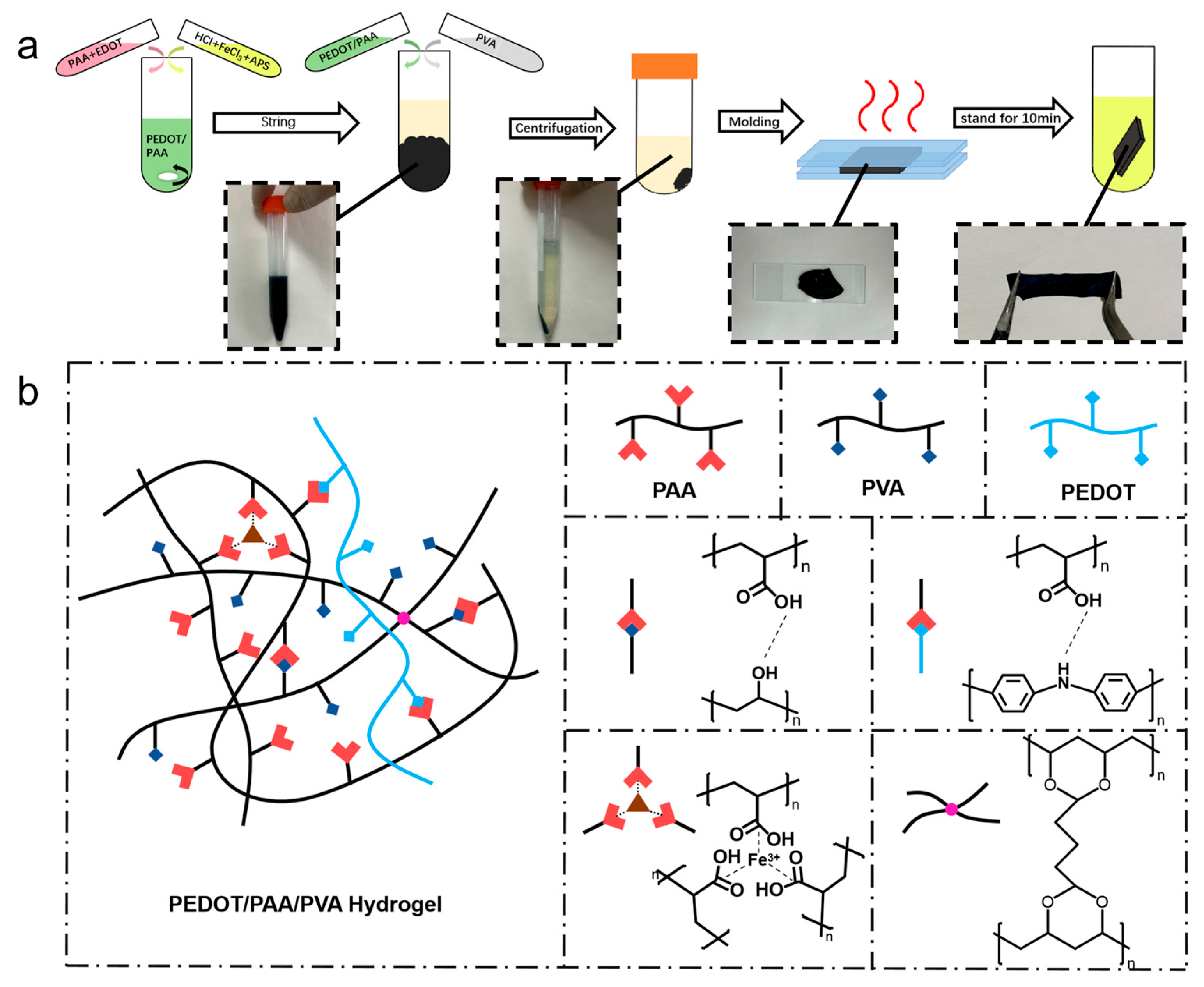
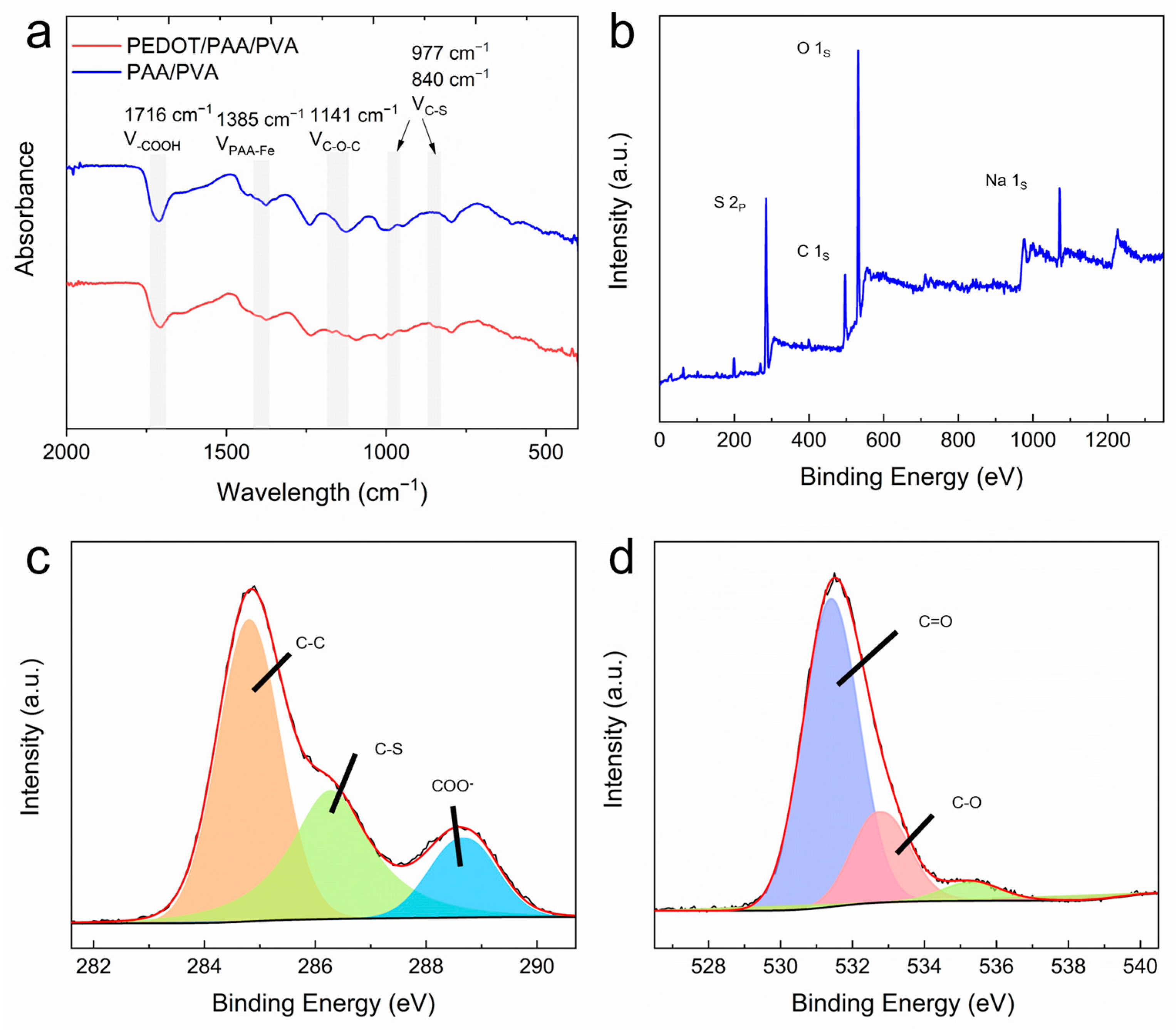

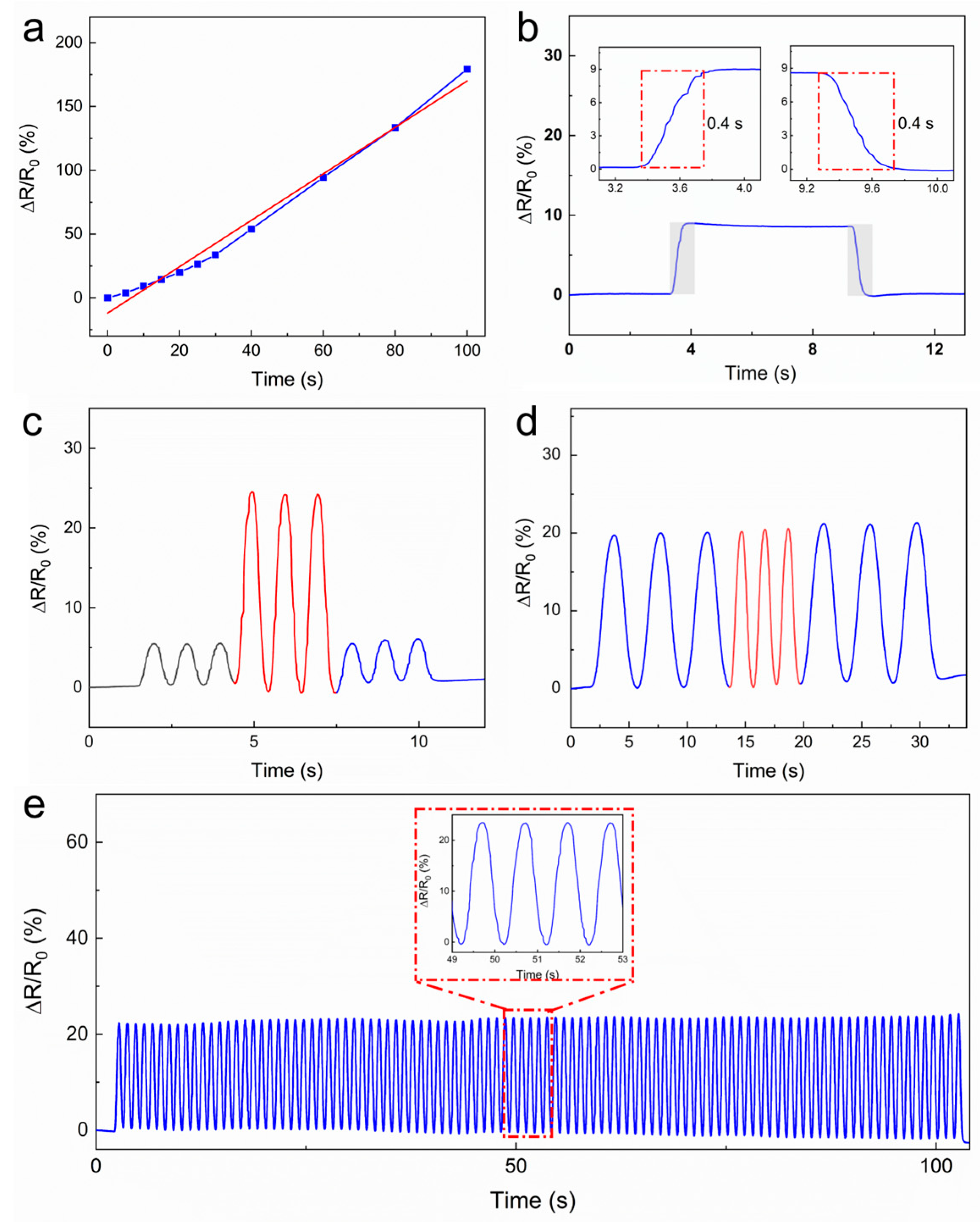
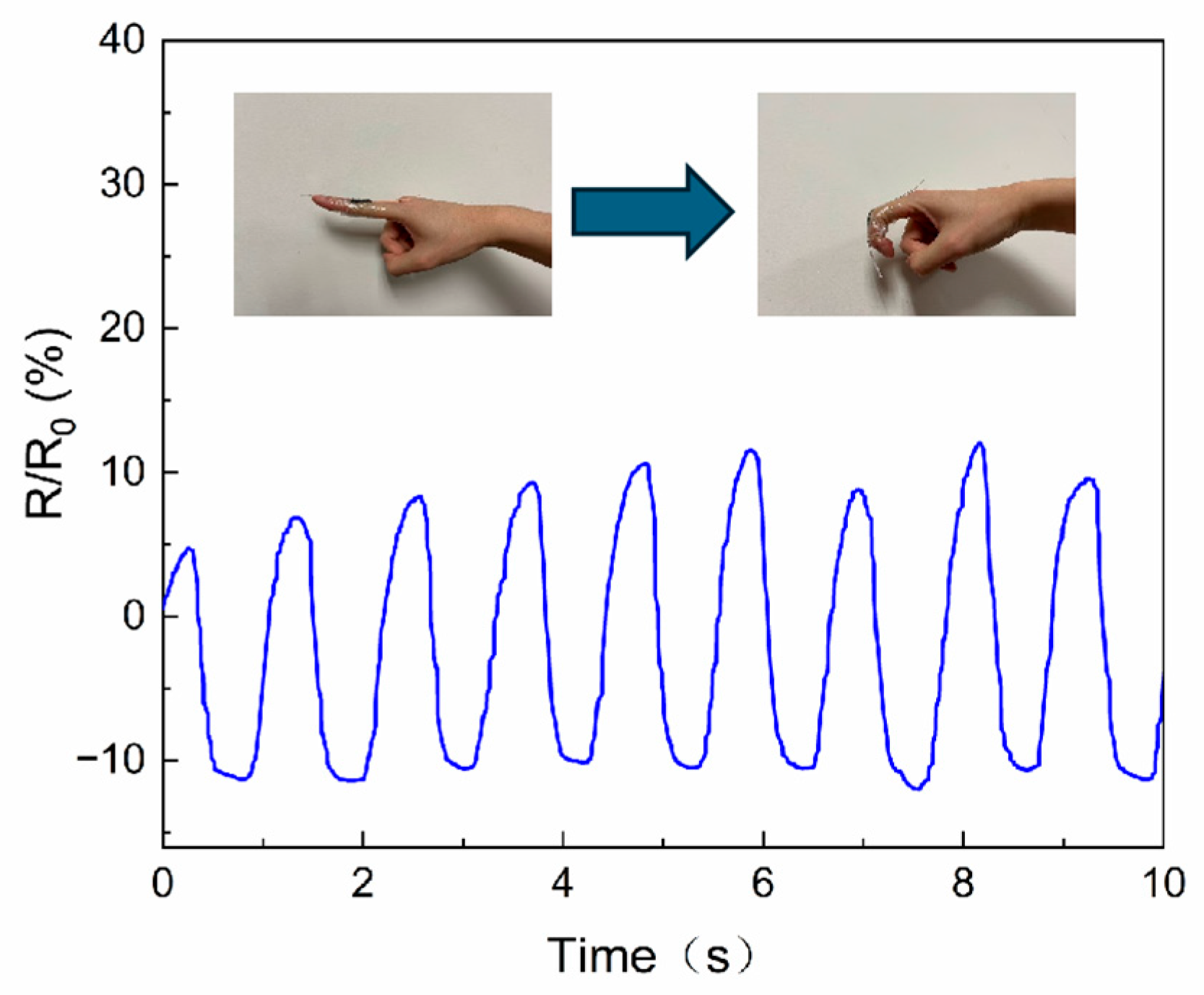
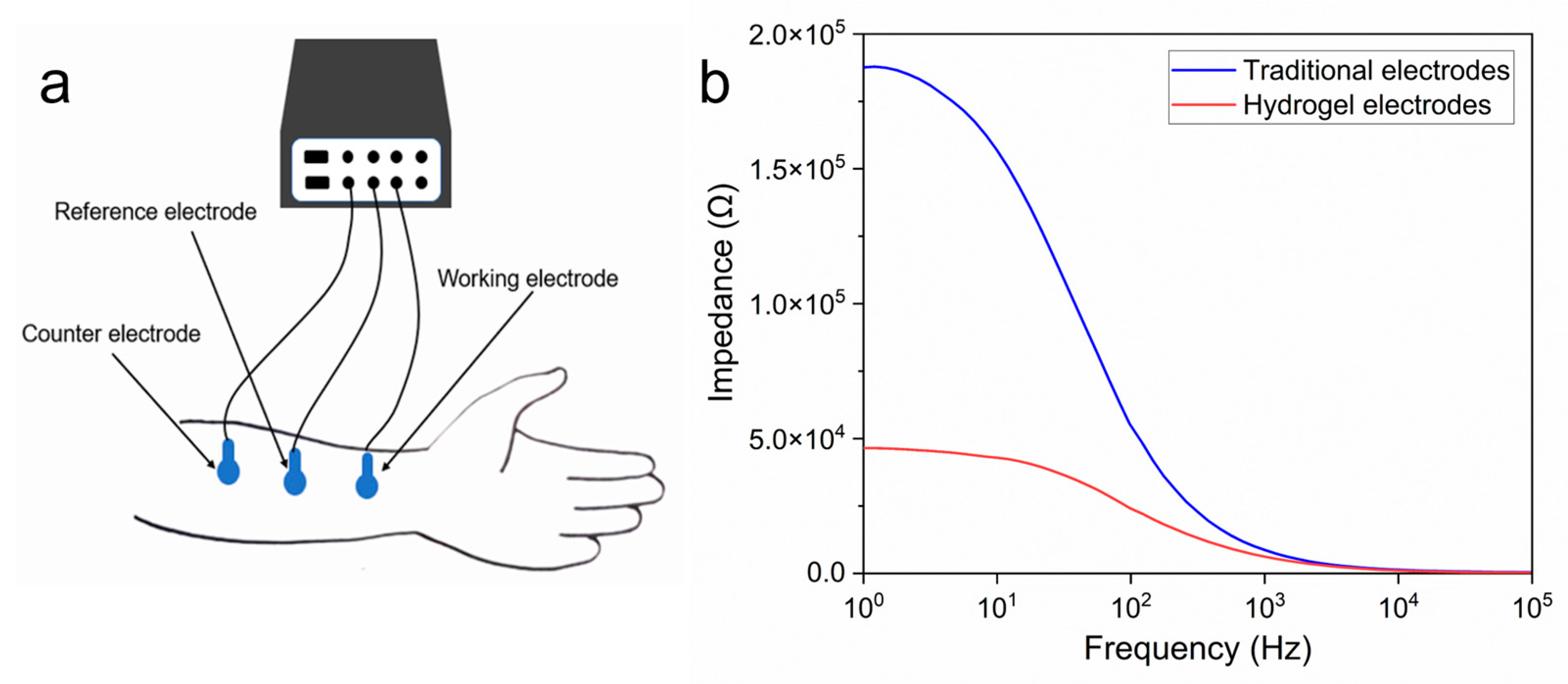
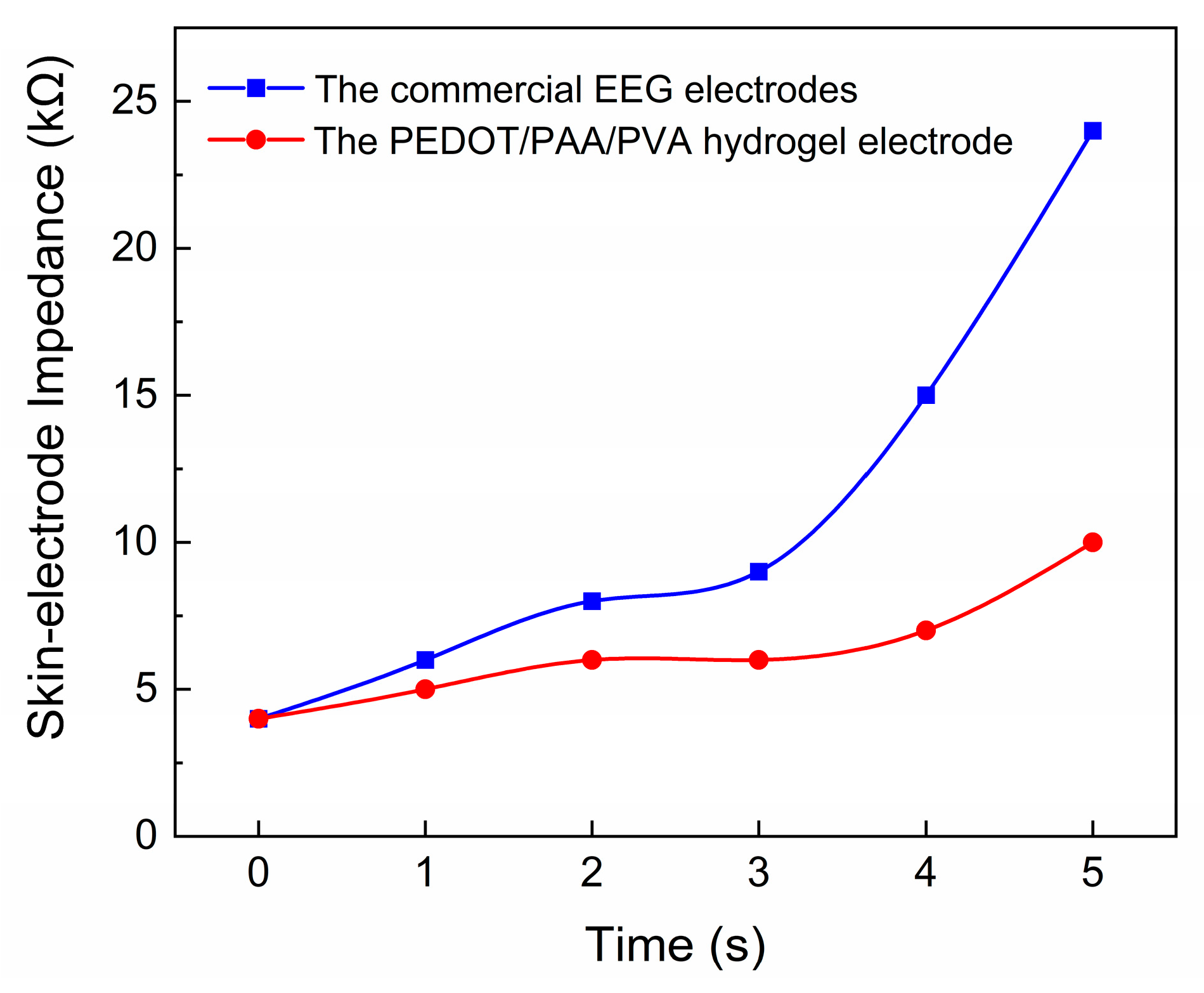

| Sample | EDOT | 10% APS |
|---|---|---|
| PEDOT5/PAA/PVA | 5 μL | 150 μL |
| PEDOT10/PAA/PVA | 10 μL | 300 μL |
| PEDOT15/PAA/PVA | 15 μL | 450 μL |
| PEDOT20/PAA/PVA | 20 μL | 600 μL |
Disclaimer/Publisher’s Note: The statements, opinions and data contained in all publications are solely those of the individual author(s) and contributor(s) and not of MDPI and/or the editor(s). MDPI and/or the editor(s) disclaim responsibility for any injury to people or property resulting from any ideas, methods, instructions or products referred to in the content. |
© 2025 by the authors. Licensee MDPI, Basel, Switzerland. This article is an open access article distributed under the terms and conditions of the Creative Commons Attribution (CC BY) license (https://creativecommons.org/licenses/by/4.0/).
Share and Cite
Wu, B.; Liu, J.; Zhao, Z.; Li, N.; Liu, B.; Zhang, H. Simple Preparation of Conductive Hydrogels Based on Precipitation Method for Flexible Wearable Devices. Sensors 2025, 25, 6032. https://doi.org/10.3390/s25196032
Wu B, Liu J, Zhao Z, Li N, Liu B, Zhang H. Simple Preparation of Conductive Hydrogels Based on Precipitation Method for Flexible Wearable Devices. Sensors. 2025; 25(19):6032. https://doi.org/10.3390/s25196032
Chicago/Turabian StyleWu, Bolan, Jiahao Liu, Zunhui Zhao, Na Li, Bo Liu, and Hangyu Zhang. 2025. "Simple Preparation of Conductive Hydrogels Based on Precipitation Method for Flexible Wearable Devices" Sensors 25, no. 19: 6032. https://doi.org/10.3390/s25196032
APA StyleWu, B., Liu, J., Zhao, Z., Li, N., Liu, B., & Zhang, H. (2025). Simple Preparation of Conductive Hydrogels Based on Precipitation Method for Flexible Wearable Devices. Sensors, 25(19), 6032. https://doi.org/10.3390/s25196032







